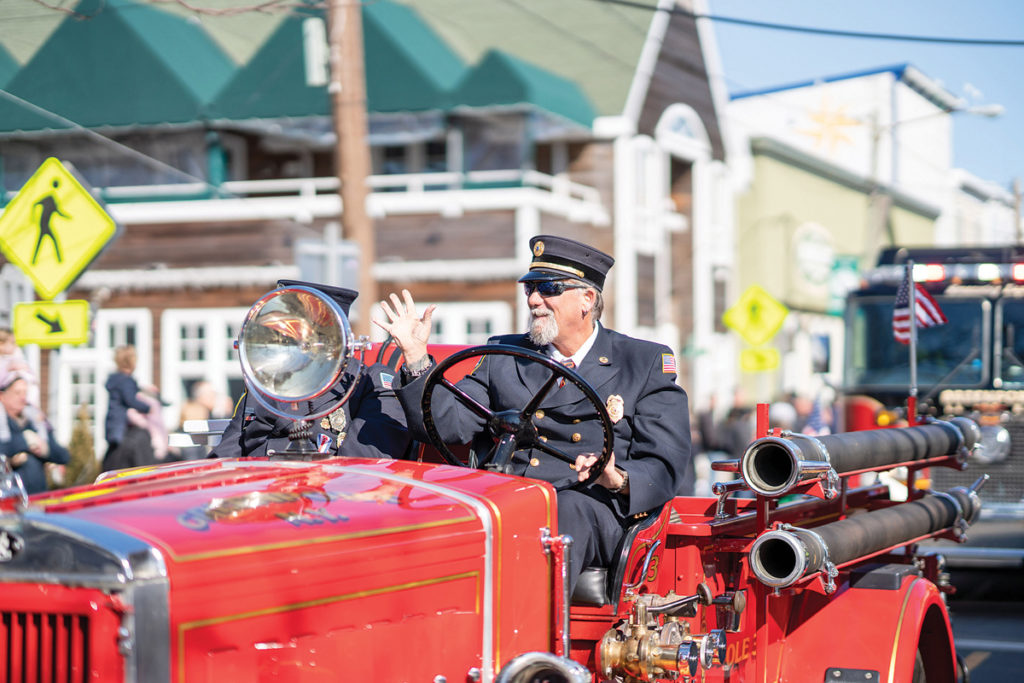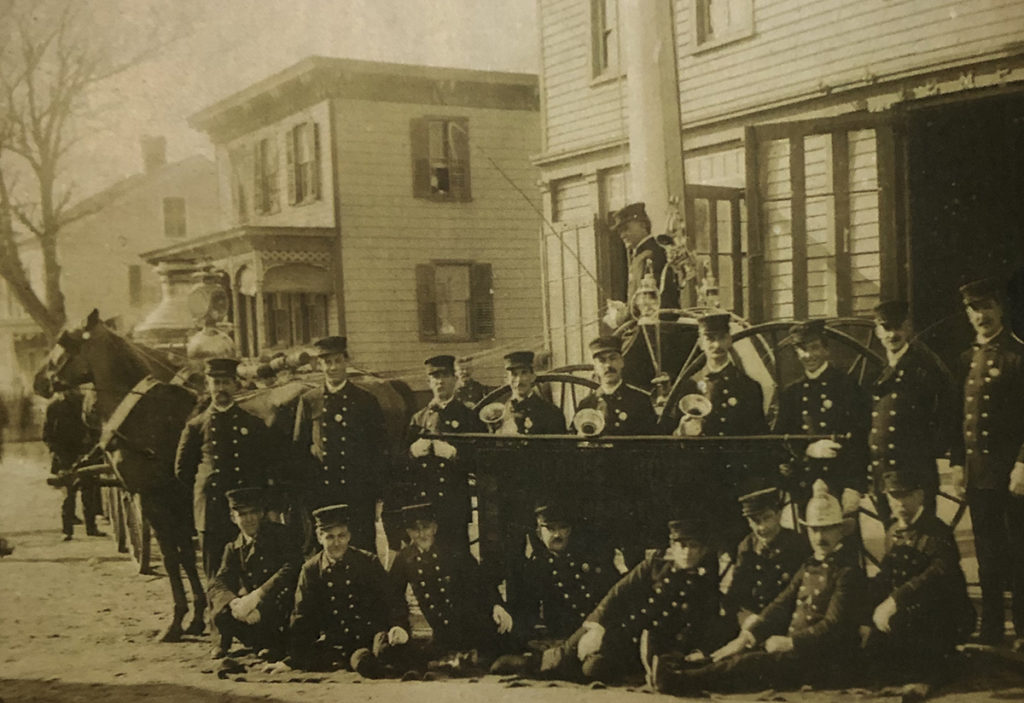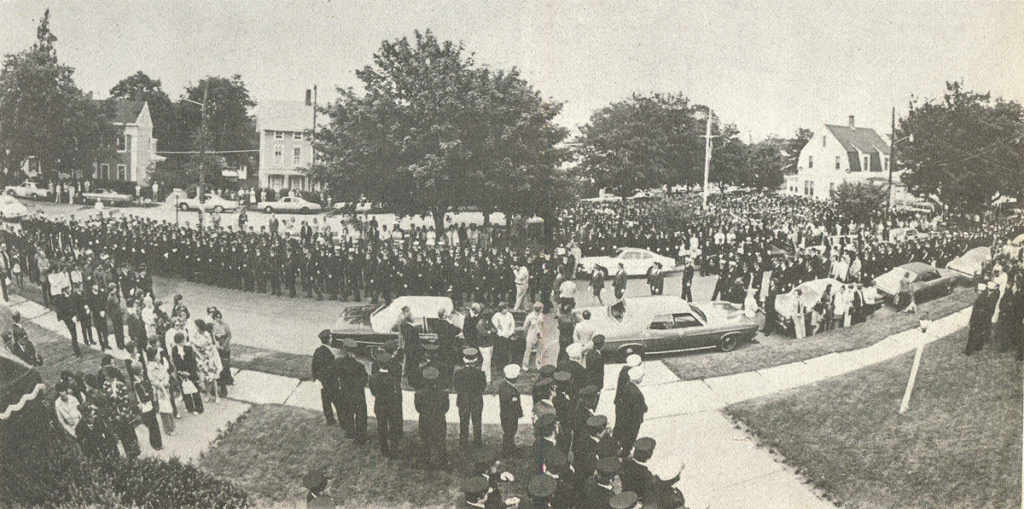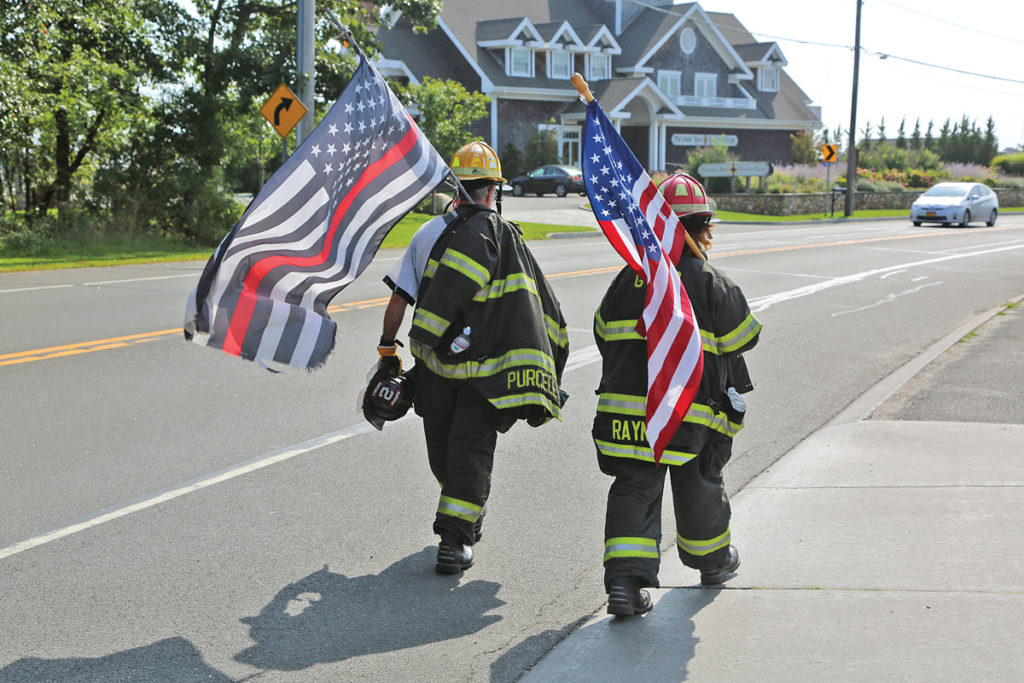Greenport firefighters celebrate department’s rich history as it turns 175

Becoming a volunteer firefighter was a natural move for Elias Zamayar.
His mother and stepfather are both members of the East Marion Fire Department, he loves helping people and he also loves the excitement of going out on a call. He loves it so much, in fact, that he happily makes the kind of sacrifices that are routine for volunteer firefighters.
After being pulled away from his job as a custodian at Greenport High School to respond to a motor vehicle accident earlier this year, Mr. Zamayar returned to work to finish his duties, and didn’t get home until after midnight. It’s what many firefighters do to fulfill obligations to both their full-time jobs and the department. And while more stringent modern requirements for firefighters and EMTs means recruiting new members can be an uphill battle for volunteer forces across Long Island, members of the Greenport Fire Department share an intense dedication to their companies and pride in their importance within the community.
That pride is easily justified. The Greenport Fire Department celebrates its 175th anniversary this year, and has the distinction of being the second-oldest volunteer fire department in the state, second only to Sag Harbor. Earlier this month, members were busy making preparations for Saturday’s annual fire department parade — which began as a celebration of George Washington’s birthday but has long since morphed into a celebration of the department — which will have special meaning thanks to the milestone anniversary.
“It’s definitely a commitment, and it’s hard because people are often working two jobs to live out here. But we’re out here for the people who can’t do it.”
Christopher Hanold
Department members gathered at the Third Street firehouse on a rainy and blustery day last week to explain why being a firefighter is so important to them, talk about the changes they’ve witnessed over the years and share stories of memorable moments — good and bad — during the course of their careers. Younger members like Mr. Zamayar mingle easily with middle-aged members like Christopher Hanold, captain of Star Hose Company No. 3, and those with decades of experience, like 52-year member John Skrezec, an ex-warden and ex-captain of Relief Hose Company No. 2. With a wry smile, he referred to himself as a “knife-and-forker” these days, but said he still comes down to the firehouse every day for coffee.
Pride in serving a department with such a rich history is plainly evident across the membership, regardless of age or years served. They are all knowledgeable about the history of the department, from its humble beginnings in 1844, when it was disbanded after only six months because they could not procure a hose for the engine or a place to house it. The department re-formed a year later, once those issues were addressed. The original hand-pumper still sits in the firehouse, tucked away in a corner behind the modern trucks, complete with a plaque that pays homage to its history. The hand-pumper was used to fight fires in Greenport until 1886, when it was replaced by a more efficient steam pumper. The old hand-pumper was restored in the 1970s by members of the department.
Greenport firefighters including Mr. Hanold, Mr. Zamayar and resident historian Bernie Purcell were happy to show off other older equipment, too, including a 1933 Mack truck in mint condition. Like the hand-pumper, this had been restored to its former glory thanks to painstaking work by department members.

A Rich History
Mr. Purcell and fellow volunteers formed a committee that put together a comprehensive history of the department — including the various iterations of different companies over the years, backstories on different pieces of vintage firefighting equipment and tales of some of the most memorable fires. All this has been documented in a journal that will be available at the parade.
Respect for the department’s history is something members of all five firefighting companies share — but Mr. Purcell is the true aficionado of that history. He has been with the Greenport department for 34 years, and served for 10 years before that with the Southold Fire Department.
Mr. Purcell spoke at length about the community collection of $750 that enabled the department to purchase the Old Philadelphia end-to-end hand-pumper, and pointed out that it’s rare to see a department with such an old piece of firefighting equipment, especially one that has been restored. He pointed out that the hand-pumper was important for the village, which was more of a city during that time.

“It was supposed to be the second Boston,” Mr. Purcell said.
After the initial hiccup with the hand-pumper, the transition to steam pumpers, which were horse- or hand-drawn, enabled the department to fight fires more efficiently. The department became fully motorized in 1920, with two pumpers and a ladder truck.
The journal also devotes pages to the old fire bell, which now sits on a brick foundation outside the main firehouse. The bell was purchased in 1880 by the Empire Engine Company and originally sat atop village hall, where it was rung in the event of a fire. The department sold the bell to the village in 1884 to purchase a headstone for former department member Robert Corey, who died in the USS Ohio explosion that year. He had been the chairman of the bell committee, and the department wanted to honor him with a headstone. The village gave the bell back to the department in the 1970s.
The department had one of its proudest moments in 1955, earning distinction as New York State Fire Department of the Year after it contained a large fire that started in the early morning hours of Nov. 21 at the docks on Main Street and threatened to level the entire waterfront area. Oil and gas tanks holding thousands of gallons of fuel were enveloped by flames, but the firefighters managed to extinguish the flames and stave off an explosion. Robert White of Relief Hose Company, who was chief at the time, presided over that fire, with assistant chiefs Joe Ficurilli and Bob Kaelin.

A Tragic Event
Over the course of nearly 200 years, the department has averted crisis many times, saving not only human lives but homes and businesses. Undoubtedly the darkest days for the department came in June 1977, when 27-year-old Rich Sycz, an ex-captain of Relief Hose Company, and 18-year-old Bruce Bellefountaine of Phenix Hook and Ladder were killed in the line of duty while responding to a residential fire. They both ran back into a burning house after the mother of a 10-year-old girl mistakenly told them her daughter was still inside. They ran out of oxygen while searching for the girl.
Four decades have not erased the pain of losing fellow firefighters. The deaths of Mr. Sycz and Mr. Bellefountaine marked the first time multiple firefighters had been lost in the line of duty in Suffolk County’s history. They remain the only Greenport firefighters to die in the line of duty. (George Matthias of Star Hose Company No. 3 died Aug. 20, 1972, in a car accident while responding to a fire call.)

The Future
In the lead-up to the annual parade, many department members were eager to talk about the future — and an alarming trend that has become an issue for volunteer forces like theirs around the country. Mr. Hanold, captain of Star Hose Company, has been a firefighter on the North Fork since 1995, coming to Greenport in 2012. He pointed out that the volunteer fire service represents billions of dollars in cost savings for the country, adding that while it is not a paid position, being a volunteer firefighter comes with plenty of incentives, from financial breaks to simple camaraderie. Mr. Hanold, who works as an ER technician at Stony Brook Eastern Long Island Hospital, acknowledged that it has become harder to be a volunteer firefighter in modern times, but said that only affirms his desire to remain a dedicated member.
“When I came out of the Army, I wanted to do something,” Mr. Hanold said. “It’s definitely a commitment, and it’s hard because people are often working two jobs to live out here. But we’re out here for the people who can’t do it.”
Mr. Purcell and other longtime members bemoaned the fact that there are far more stringent and time-consuming requirements to become a firefighter these days, and said that many locals simply can’t make that commitment. The department is allowed to carry up to 45 members in each of its five companies, but Mr. Purcell said the rolls right now are down to around 123 members overall. He acknowledged that with the top-of-the-line firefighting vehicles and equipment available these days, the department doesn’t need a full complement of members, but he said the community feels the pinch when it comes to EMS services.
Pete Harris, who joined the department in 1971, remembered a time when there was a waiting list to join. He reminisced about his earlier days as a volunteer, and takes pride in the way the department handled several fires at that time.
“There were some major fires in the village in the business district that very well could have taken out whole blocks, and they did a terrific job saving those areas,” he said of his fellow firefighters. He said that while there are still several families in the area who are keeping up the tradition of being part of the department, he isn’t sure if the current way of doing things will be sustainable for local volunteer forces on the twin forks in the future.
“I foresee, maybe 10 years down the road, that there will end up being some paid fire people here on call during the day,” he said. “I joined when I was 18 and I’ll be 67 years old next month. It’s a young man’s game.”
Mr. Harris and several of his peers said they’d continue to answer calls as long as they felt able, and added that the continued support of the community — from when it first organized and purchased the hand-pumper to the current day — is what helps ensure the department will continue to stay strong.
“We’re proud of what we do,” Mr. Harris said. “We had a call the other night where someone spotted a fire across the street from the IGA, and the next day on Facebook there was a whole list of people saying what a good job we did, how quickly we got there and how we were able to stave off what could have been a devastating fire.”








